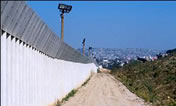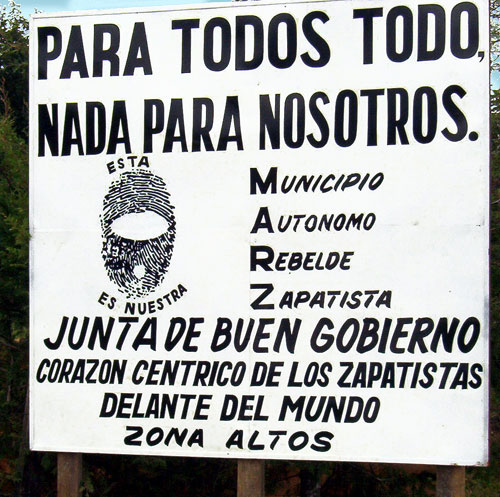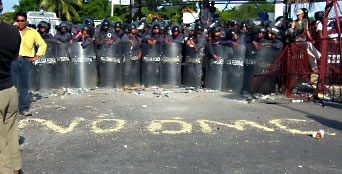SIPAZ Activities (May – August 2003)
29/08/20032003
31/12/2003Part of my work at SIPAZ consists of receiving visitors and delegations, many of which arrive from the United States. Also, volunteers from the U.S. come to live and work in Chiapas, exchanging experiences for a time and then returning to their own country. Mexicans who live in the United States also come and visit us. Finally, the majority of the organizations that form part of the coalition of SIPAZ as well as various members of our board of directors, currently or in the past, are U.S.citizens.
Responding to invitations from some of these contacts and friends, I worked together with them to plan my trip to the United States in October and the beginning of November. I visited eight states: Texas, Minnesota, Wisconsin, Illinois, Michigan, Ohio, California, and Arizona. Through public presentations at meetings, schools, universities, factories, churches, and community radio, I presented the situation in Chiapas and the work of SIPAZ close to fifty times.
This visit not only permitted me to tell about our work and the situation in Chiapas. It also resulted in a rich and diverse interchange of experiences, dreams and ideas of how to continue working for a better word.
Border encounters, global problems
In my presentations on Chiapas, I mentioned the North American Free Trade Agreement (NAFTA, or TLCAN in Spanish) as one of the fuels of the explosive uprising of ’94 in Chiapas. In El Paso, Texas, I visited a house for immigrants and a center for women laborers. A Mexican commented to me: “Before there were many textile factories. Many Mexicans made good wages in these factories. With NAFTA, the maquiladoras moved to the northern states of Mexico, leaving a lot of unemployment. They hired Mexicans at a much lower salary. Now they have moved to Central America and Asia, leaving a dependent economy and a damaged environment.”
At the house for immigrants, I met many Mexicans from the Northern States of Mexico, the undocumented who cross the border looking for a job and with dreams of success. They told me that after the attacks on the Word Trade Center on September 11th the United States has increased the control over the border and that the border patrols now carry military grade weapons. They spoke of how the border patrols have already killed people (one young person in front of the very same house in which we were speaking). There are many stories along the border to discourage the thousands and thousands of Mexicans who dream of or are actually going to the North (el Norte), looking for a better future.
In Nogales, Arizona, a wall marks the border between Mexico and the United States and it reminds me of other images and other times in my own country: Germany. Because of this wall, most of the undocumented cross the border far from the cities, in the deserts of Texas and Arizona. Walking up to 80 Km in the desert, many have died, almost all from a lack of water.
At the University of Austin, Texas, my visit coincided with that of the president of Mexico, Vicente Fox. Many of those present were Mexican immigrants. He spoke principally about his work lobbying the governments of border states in the U.S. and Mexico around Migratory Policy. He endorsed the immigrant workers (the dollars that they send to their families is the largest single source of income of Mexico). He received much applause. But there were also people in the reception hall holding up protest banners: “Murders of women in Juarez,” “San Andres Accords,” ” You promised to resolve the Chiapas problem in 15 minutes,” “EZLN.” The speech ended, but the discussion continued among those present, and it was apparent that there are many different opinions on these issues among the Mexican immigrants.
The economic interdependency of Mexico and its “big brother” in the North has left me to conclude that “walls” (both figurative and literal) are not a solution for the long term. This interdependence already is a fact, and the pressure of immigration continues to increase from the South (including farther away than Chiapas, the southern frontier of Mexico) because of the deteriorating economy that they experience in those regions.
Common struggles and responses of solidarity
In Tucson, Arizona, I met organized volunteers at “Human Borders” who take water to the desert to help save the lives of immigrants. Others go to Altar, a border town, with clothes and food. “Borderlinks” in Tucson organizes delegations that go to learn about the situation on the border, to interview the border patrols, immigration, and the Mexicans on both sides of the border. In El Paso, Texas, and Juarez, Chihuahua, Mexico there are shelters, houses for women and for immigrants maintained by volunteers, with donations of funds and leftover food that never would be missed in this society of abundance. I witnessed many people who are very committed to others, to the homeless from the U.S. or to immigrants who have come looking for a way to survive.
Tucson is the cradle of the Sanctuary Movement, which has traditionally helped war refugees from Central America, offering them security and space in which to speak out. Also they have worked to “educate” the people of the United States, recognizing the great responsibility that their country has had in these wars. This approach entails a challenge: more than works of charity and help, it recognizes that as citizens of first world countries we are part of the problems and of the integral solutions that are required.
In Mexico, I also encountered themes of shared struggles, in particular against the mega economic projects (NAFTA, FTAA) and the powers that promote them (WTO, World Bank, etc.) In the US I met people who were planning to participate in the protests against the FTAA in Miami, in favor of immigrant rights, or who were writing letters and visiting their congressional representatives in the ongoing work of lobbying. They commented to me that it is not easy when the large companies with many more resources lobby for policies which go against the interests of these struggles in order to be able to continue with their businesses.
Many military officials from Mexico and other countries of the continent are trained in military schools in the United States. Each year large protests are organized against the “School of the Americas” and other military schools. Many activists have been incarcerated for participating in these types of activities. This year in November, different groups were working to demonstrate south-north solidarity. They were organizing for anti-military protests taking place all over the continent on the same date as the protest against the “School of the Americas” (Georgia, U.S.).
And me, what with all this?
On several occasions I was invited to speak in high schools and universities. Children and young people were highly interested in my story. Why did you decide to live this life? Why do you like it? You don’t have a husband, children, etc.? Others asked what they could they do as young people within and outside of their country. I am inviting some colleges and universities to organize delegations to learn more directly about the life of the indigenous peoples in Chiapas.
In the United States, at first glance everything is big: the roads, the cars, the people…Later, one notes the abundance, the use of resources without thought: water, gasoline, telephones and food. I imagine that it is dificult for someone to die of hunger in the United States; the poor can live off what others throw away. To have fun seems to be what is most important. Many people take care of their bodies, either in large gyms or going (in their cars!) to a place where they can run or walk. Many seem to work only to have more money and so they can spend it on entertainment.
An activist friend says: “A majority of ‘gringos’ live in a box, from which they watch their work, their money, their entertainment.To leave this box, to see the world involves an action. It is difficult to bring most people out of this box. If you do it too fast they get scared and go back…”
Also coming from a country in the first world, I am left reflecting on the work being done and all the work that remains in the North, recognizing that we are in the same boat called Planet Earth. What more can we do? It is a job shared by many people, the United States included.



